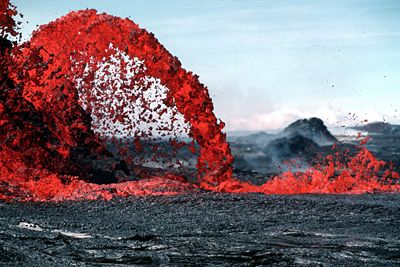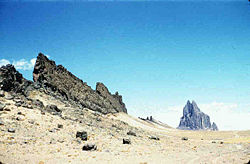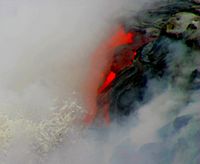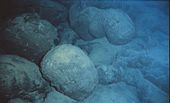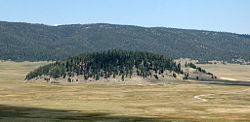Lava
Lava is molten rock expelled by a volcano during an eruption. (When the molten rock is beneath the Earth's surface, it is called magma.) When first exuded from a volcanic vent, the hot lava is at temperatures ranging from 700 ┬░C to 1,200 ┬░C (1,300 ┬░F to 2,200 ┬░F). The material is highly viscous, with a viscosity about 100,000 times that of water, but it can flow great distances before cooling and solidifying. The hardened formation is called "lava flow," whereas the material that still contains molten rock is called an "active lava flow." The rock formed from solidified lava (or magma) is called igneous rock.
Active lava flows result in enormous loss of property, but they are usually slow enough for people to escape out of harm's way. Yet, injuries and loss of life have resulted when escape routes have been cut off and when individuals have been too close to the flow. On rare occasions, the lava has moved too quickly. More often, deaths associated with volcanoes are attributable to other ejecta and explosions, as noted below (under Hazards).
On the positive side, the scientific study of lavas helps us understand the structure, composition, and evolution of the Earth's crust and mantle. Also, as the solidified lava breaks down, new vegetation and animal life begin to appear, providing the opportunity to study how a new ecosystem is created.
Etymology
The word lava comes from Italian, and is probably derived from the Latin word labes which means a fall, slide, or sinking in. The first use in connection with extruded magma was apparently in a short account written by Francesco Serao[1] on the eruption of Vesuvius between May 14 and June 4, 1737. Serao described "a flow of fiery lava" as an analogy to the flow of water and mud down the flanks of the volcano following heavy rain.
Lava composition
In general, a lava's composition determines its behavior more than the temperature of its eruption. Igneous rocks, formed from solidified lava, can be classified into three chemical types: felsic, intermediate, and mafic. These classes are primarily chemical, but the chemistry of lava also tends to correlate with the magma temperature, viscosity, and mode of eruption.
Felsic lavas, such as rhyolite and dacite, are often associated with strombolian eruptions, typically form lava domes and sheeted flows, and are associated with pyroclastic surge deposits and tuffs. Felsic lavas are extremely viscous. This is caused primarily by the chemistry of the magma, which is high in silica, aluminum, potassium, sodium, and calcium, forming a polymerized liquid rich in feldspar and quartz, which is thus much more sticky than other magma types. Felsic magmas can erupt at temperatures as low as 650 to 750 degrees Celsius, although they can be hotter.
Intermediate or andesitic lavas are lower in aluminum and silica, and usually somewhat richer in magnesium and iron. Intermediate lavas form andesite domes and sheeted flows, are usually associated with strombolian eruptions, and form composite volcanoes. Poorer in aluminum and silica than felsic lavas, and also hotter (in the range of 750 to 950 ┬░C), they tend to be less viscous. Greater temperatures tend to destroy polymerized bonds within the magma, promoting more fluid behaviour and also a greater tendency to form phenocrysts. Higher iron and magnesium tends to manifest as a darker groundmass, and also occasionally amphibole or pyroxene phenocrysts.
Mafic or basaltic lavas are typified by their high ferromagnesian content, and generally erupt at temperatures in excess of 950 ┬░C. Basaltic magma is high in iron and magnesium, and has relatively lower aluminium and silica, which taken together reduces the degree of polymerization within the melt. Due to the higher temperatures, viscosities can be relatively low, although still thousands of times more viscous than water. The low degree of polymerization and high temperature favors chemical diffusion, so it is common to see large, well-formed phenocrysts within mafic lavas. Basalt volcanoes tend to form shield volcanoes, as the fluid magma tends to form thin, widely distributed flows.
Ultramafic lavas such as komatiite and highly magnesian magmas which form boninite take the composition and temperatures of eruptions to the extreme. Komatiites contain over 18 percent magnesium oxide, and are thought to have erupted at temperatures of 1600 ┬░C. At this temperature there is no polymerization of the mineral compounds, creating a highly mobile liquid with viscosity as low as that of water. Most if not all ultramafic lavas are no younger than the Proterozoic, with a few ultramafic magmas known from the Phanerozoic. No modern komatiite lavas are known, as the Earth's mantle has cooled too much to produce highly magnesian magmas.
Lava behavior
The viscosity of lava is important because it determines how the lava will behave. Lavas with high viscosity are rhyolite, dacite, andesite, and trachyte, with cooled basaltic lava also quite viscous; those with low viscosities are freshly erupted basalt, carbonatite, and the unusual sulphide lavas, and occasionally andesite.
Highly viscous lava has the following types of behavior:
- It tends to flow slowly, clog, and form semi-solid blocks that resist flow.
- It tends to entrap gasses, which form bubbles within the rock as they rise to the surface.
- It correlates with explosive or phreatic eruptions and is associated with tuff and pyroclastic flows.[2]
Highly viscous lavas do not usually flow as liquid, and usually form explosive fragmental ash and tephra deposits. However, a degassed viscous lava or one that erupts somewhat hotter than usual may form a lava flow. Viscous lavas have two forms of non-pyroclastic eruptions, lava domes and sheeted flows.
Lava with low viscosity shows the following types of behavior:
- It tends to flow easily, forming puddles, channels, and rivers of molten rock.
- It tends to easily release bubbling gases as they are formed.
- Eruptions are rarely pyroclastic and are usually quiescent.
- Volcanoes tend to form as rifts, not steep cones.
There are three forms of low-viscosity lava flows: ╩╗a╩╗─ü, p─ühoehoe, and pillow lava. They are described below, in relation to basaltic flows from Hawaii.
Lavas may also contain many other components, sometimes including solid crystals of various minerals, fragments of exotic rocks known as xenoliths, and parts of its own solidified lava products.
Volcanic morphologies
The physical behavior of lava creates the physical forms of a lava flow or volcano. More fluid basaltic lava flows tend to form flat sheets and lobes of lava, whereas viscous rhyolite forms knobbly, rubbly masses of rock.
General features of volcanology can be used to classify volcanic edifices and provide information on the eruptions which formed the lava flow, even if the sequence of lavas have been buried or metamorphosed.
The ideal lava flow will have a brecciated top, either as pillow lava development, autobreccia and rubble typical of ╩╗a╩╗─ü and viscous flows, or a vesicular or frothy carapace such as scoria or pumice. The flow top will tend to be glassy, having been flash frozen in contact with the air or water.
The center of the lava flow will ideally be massive and crystalline, though usually the crystals will be microscopic. The more viscous lava forms tend to show sheeted flow features, and blocks or breccia entrained within the sticky lava. The crystal size at the centre of a lava will in general be greater than at the margins, as the crystals have more time to grow.
The flow base tends to show evidence of hydrothermal activity, generally because the lava is erupted onto moist or wet substrates. The flow base may have vesicles, perhaps filled with minerals (amygdules). The substrate upon which the lava has flowed may show signs of scouring, it may be broken or disturbed due to the boiling of trapped water, and in the case of soil profiles, may be baked into a brick-red clay.
Discriminating between a sill and a lava flow in ancient rock sequences can be difficult. However, sills do not usually have brecciated margins, they show greater propensity to form a chilled margin, and may show a weak metamorphic aureole on both the upper and lower surface whereas a lava flow will only metamorphose the lower surface. However, it is often difficult in practice to identify these metamorphic phenomenon because they are usually weak and restricted in size.
Lava domes
Cooling viscous lava often clogs a volcanic vent, allowing pressure behind the blockage to build; trapped gasses within the lava also add to the pressure, eventually producing cataclysmic explosions, ejecting great clouds of volcanic ash and gas, and producing pyroclastic flows. Most explosive eruptions tend to be followed by a quieter period of lava extrusion.
Sometimes as a volcano extrudes silicic lava, it forms an inflation dome, gradually building up a large, pillow-like structure which cracks, fissures, and may release cooled chunks of rock and rubble. The top and side margins of an inflating lava dome tend to be covered in fragments of rock, breccia and ash.
Examples of lava dome eruptions include the Novarupta dome, and successive lava domes of Mount St Helens.
Sheeted flows
Sheeted flows are an uncommon form of eruptive phenomena of felsic and intermediate volcanoes. Internal pressure of gases tend to promote pyroclastic and explosive eruptions. However, a viscous magma will flow, though very slowly, across the surface of the Earth.
Typically the lava flow forms a sheeted flow or laminar flow, with the upper and lower margins of the flowing lava forming a hard, brittle shell inside of which the sticky, viscous lava will be flowing. The hard skin forms a chaotic igneous breccia called autobreccia, as the flow creeps along, churning the outer margins apart. This is similar to an ╩╗a╩╗─ü flow except that the inner lava will show evidence of stretching, plastic deformation and even foliation of the highly viscous lava.
Examples of laminar or sheeted flows include the Tertiary aged volcanic edifices of the Glasshouse mountains, and the cliffs of Kangaroo Point in Brisbane, Australia.
╩╗A╩╗─ü
╩╗A╩╗─ü (also spelled aa, a╩╗a, ╩╗a╩╗a and aa-aa, IPA: /╦ł╩ö╔Ĺ╦É╩ö╔Ĺ╦É/, Hawaiian English, from Hawaiian meaning "stony with rough lava," but also to "burn" or "blaze") is one of three basic types of flow lava. ╩╗A╩╗─ü is basaltic lava characterized by a rough or rubbly surface composed of broken lava blocks called clinker.
The loose, broken, and sharp, spiny surface of a solidified ╩╗a╩╗─ü flow makes walking difficult and slow. (Walking upon a nonsolidified ╩╗a╩╗─ü flow is not advised.) The clinkery surface actually covers a massive dense core, which was the most active part of the flow. As pasty lava in the core travels downslope, the clinkers are carried along at the surface. At the leading edge of an ╩╗a╩╗─ü flow, however, these cooled fragments tumble down the steep front and are buried by the advancing flow. This produces a layer of lava fragments both at the bottom and top of an ╩╗a╩╗─ü flow.
Accretionary lava balls as large as 3 m (10 ft) are common on ╩╗a╩╗─ü flows. ╩╗A╩╗─ü is usually of higher viscosity than p─ühoehoe (often spelled pahoehoe). P─ühoehoe can turn into ╩╗a╩╗─ü if it becomes turbulent due to meeting impediments or steep slopes.
The sharp, angled texture makes ╩╗a╩╗─ü a strong radar reflector, and can easily be seen from an orbiting satellite (bright on Magellan pictures).
The temperature of ╩╗a╩╗─ü typically ranges between 1,000┬║C and 1,100┬║C .
P─ühoehoe
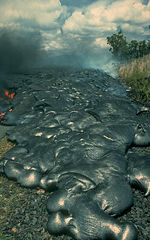
P─ühoehoe (also spelled pahoehoe, IPA: /p╔Ö╦łh╔Ö╩Ő╔¬h╔Ö╩Ői/, Hawaiian English, from Hawaiian, meaning "smooth, unbroken lava") is basaltic lava that has a smooth, billowy, undulating, or ropy surface. These surface features are due to the movement of very fluid lava under a congealing surface crust.
A p─ühoehoe flow typically advances as a series of small lobes and toes that continually break out from a cooled crust. Also forms lava tubes where the minimal heat loss maintains low viscosity. The surface texture of p─ühoehoe flows varies widely, displaying all kinds of bizarre shapes often referred to as lava sculpture. With increasing distance from the source, p─ühoehoe flows may change into ╩╗a╩╗─ü flows in response to heat loss and consequent increase in viscosity. Pahoehoe lavas typically have a temperature of 1,100┬║C - 1,200┬║C
The rounded texture makes p─ühoehoe a poor radar reflector, and is difficult to see from an orbiting satellite (dark on Magellan pictures).
Pillow lava
Pillow lava is the rock type typically formed when lava emerges from an underwater volcanic vent or a lava flow enters the ocean. The viscous lava gains a solid crust immediately upon contact with the water, and this crust cracks and oozes additional large blobs or "pillows" as more lava emerges from the advancing flow. Since the majority of Earth's surface is covered by water, and most volcanoes are situated near or under it, pillow lava is very common. Examples of this can be seen at Llanddwyn Island.
Lava landforms
Due to being formed from viscous molten rock, lava flows and eruptions create distinctive formations, landforms and topographical features from the macroscopic to the microscopic.
Volcanoes
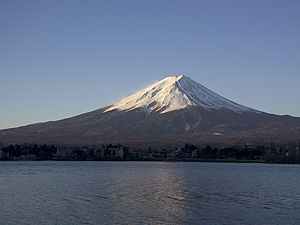
Volcanoes are the primary landform created by lava eruption and consist of flattish, shallow shield volcanoes formed from basalt to steeply-sided ash and lava composite volcanic cones typical of andesite and rhyolite lavas.
Volcanoes can form calderas if they are obliterated by large pyroclastic or phreatic eruptions, and such features typically include volcanic crater lakes and lava domes after the event.
Cinder and spatter cones
Cinder cones and spatter cones are small-scale features formed by lava accumulation around a small vent on a volcanic edifice. Cinder cones are formed from tephra or ash and tuff which is thrown from an explosive vent. Spatter cones are formed by accumulation of molten volcanic slag and cinders ejected in a more liquid form.
Lava domes
Lava domes are formed by the extrusion of viscous felsic magma. They can form prominent rounded protuberances, such as at Valle Calderas.
Lava tubes
Lava tubes are formed when a flow of relatively fluid lava cools on the upper surface sufficiently to form a crust. Beneath this crust, which by dint of being made of rock is an excellent insulator, the lava can continue to flow as a liquid. When this flow occurs over a prolonged period of time the lava conduit can form a tunnel-like aperture or lava tube, which can conduct molten rock many kilometers from the vent without cooling appreciably. Often these lava tubes drain out once the supply of fresh lava has stopped, leaving a considerable length of open tunnel within the lava flow.
Lava tubes are known from the modern day eruptions of K─źlauea, and significant, extensive and open lava tubes of Tertiary age are known from North Queensland, Australia, some extending for 15 kilometers.
Lava cascades and fountains
The eruptions of lava are sometimes attended by peculiarities that add to their grandeur. In some instances, the fiery stream has plunged over a sheer precipice of immense height, so as to produce a glowing cascade exceeding (in breadth and perpendicular descent) the celebrated Niagara Falls. In other cases, the lava, instead of flowing immediately down the sides of the mountain, has been first thrown up into the air as a fiery fountain several hundred feet in height.
Lava lakes
Rarely, a volcanic cone may fill with lava but not erupt. Lava that forms a pool within the caldera is known as a lava lake. Lava lakes do not usually persist for long, either draining back into the magma chamber once pressure is relieved (usually by venting of gases through the caldera), or by draining via eruption of lava flows or pyroclastic explosion.
There are only a few sites in the world where permanent lakes of lava exist. These include:
- Mount Erebus, Antarctica
- K─źlauea Volcano, Hawai╩╗i
- Erta Ale, Ethiopia
- Nyiragongo, Democratic Republic of Congo
Composition of volcanic rocks

The subfamily of rocks formed from volcanic lava are called igneous volcanic rocks. (This term differentiates them from igneous rocks formed from magma, below the surface of the earth, called igneous plutonic rocks).
The lavas of different volcanoes, when cooled and hardened, differ much in their appearance and composition. If a rhyolite lava-stream cools quickly, it can quickly freeze into a black glassy material called obsidian. When filled with bubbles of gas, the same lava may form the spongy mineral pumice.
The lavas, having cooled rapidly in contact with the air or water, are mostly finely crystalline or have at least fine-grained ground-mass representing that part of the viscous semi-crystalline lava flow which was still liquid at the moment of eruption. At this time they were exposed to atmospheric pressure and the steam and other gases within them were free to escape. Many important modifications arise from this, the most striking being the frequent presence of numerous steam cavities (vesicular structure) often drawn out to elongated shapes subsequently filled up with minerals by infiltration (amygdaloidal structure).
Most lavas have fallen considerably below their original temperatures before they are emitted. Their behavior is analogous to hot solutions of salts in water. When approaching the saturation temperature, they first deposit a crop of large, well-formed crystals (labile stage) and subsequently precipitate clouds of smaller less perfect crystalline particles (metastable stage). In igneous rocks, the first generation of crystals generally forms during the ascent from the subterranean depths to the crater of the volcano. It has frequently been verified by observation that freshly emitted lavas contain large crystals borne along in a molten, liquid mass.
Unusual lavas
Four types of unusual volcanic rocks have been recognized as erupting onto the surface of the Earth:
- Carbonatite and natrocarbonatite lavas are known from the Ol Doinyo Lengai volcano in Tanzania, the sole example of an active carbonatite volcano.[3]
- Copper sulfide bearing lavas have been recognized in Chile and Bolivia[4]
- Iron oxide lavas are thought to be the source of the iron ore at in Chile and at Kiruna, Sweden (erupted in the Proterozoic).[5]
- Olivine nephelinite lavas are a unique type thought to have come from much deeper within the mantle of the Earth.
Hazards
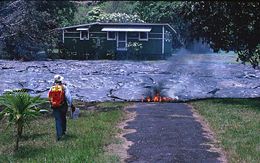
Lava flows are enormously destructive to property in their path, but they generally move slowly enough for people to get out of their way. Consequently, casualties caused directly by active lava flows are rare. Nevertheless, injuries and deaths have occurred when people had their escape routes cut off, or if they were too close to the flow,[6] or (more rarely) if the lava flow front traveled too quickly.
A notable example of loss of life by rapid lava flow is the eruption of Nyiragongo in Zaire (now Democratic Republic of Congo) on January 10, 1977. The crater wall was breached during the night and the fluid lava lake in it drained out in less than an hour. Flowing down the steep slopes of the volcano at up to 60 miles per hour (100 km per hour), the lava swiftly overwhelmed several villages whilst their residents were asleep. In light of this disaster, the mountain was designated a Decade Volcano in 1991[7][8]
Deaths attributed to volcanoes frequently have a different cause, for example volcanic ejecta, pyroclastic flow from a collapsing lava dome, lahars,[9] or explosions caused when the flow comes into contact with water[6].
Towns destroyed by lava flows
- Kaim┼ź, Hawai╩╗i (abandoned)
- Kalapana, Hawai╩╗i (abandoned)
- Kapoho, Hawai╩╗i (abandoned)
- Keawaiki, Hawai╩╗i (abandoned)
- Koa╩╗e, Hawai╩╗i (abandoned)
- San Sebastiano al Vesuvio, Italy (rebuilt)
Towns partially destroyed by lava flows
- Pompeii, Italy, in the eruption of Mount Vesuvius in August 23, 79 C.E.
- Catania, Italy, in the eruption of Mount Etna in 1669 (rebuilt)
- Goma, Democratic Republic of Congo, in the eruption of Nyiragongo in 2002
- Heimaey, Iceland, in the 1973 Eldfell eruption (rebuilt)
- Royal Gardens, Hawai╩╗i, by the eruption of Kilauea in 1986-1987 (abandoned)
- Par├şcutin (village the volcano was named after) and San Juan Parangaricutiro, Mexico, by the eruption of Par├şcutin from 1943 to 1952.
Colonization by living organisms
Initially, a lava flow is inhospitable to life. Its mineral content is not accessible to living things, and it may leak harmful gases, including hydrogen sulfide. Some months after the eruption, as the volcanic rock begins to break down, it forms protosoil that includes minerals and clays. In areas that receive plentiful rain, fertile soils start forming, and algae and ferns begin to colonize the fissures where water may accumulate. Insects are also drawn to the cracks and openings where organic debris from surrounding areas may be trapped. Later, as the insect and plant life develops, birds are attracted to the area as well. In addition, lava tubes become colonized by cave-adapted insects. In this manner, new ecosystems develop.[10]
Notes
- ÔćĹ Vesuvius Erupts, 1738. Linda Hall Library of Science, Engineering and Technology. Retrieved April 24, 2007.
- ÔćĹ A pyroclastic flow is a fast-moving, fluidized body of hot gas, ash, and rock (collectively known as tephra) that travels away from the vent, normally hugging the ground.
- ÔćĹ How Volcanoes Work: Unusual Lava Types. Geology, San Diego State University. Retrieved April 24, 2007.
- ÔćĹ John M. Guilbert, and Charles F. Park, Jr., The Geology of Ore Deposits (W. H. Freeman, 1986. ISBN 0716714566), 556-557.
- ÔćĹ John M. Guilbert and Charles F. Park, Jr., The Geology of Ore Deposits (W. H. Freeman, 1986. ISBN 0716714566), 404-405.
- ÔćĹ 6.0 6.1 Lava Flows and Their Effects USGS Volcano Hazards Program. Retrieved April 24, 2007.
- ÔćĹ NyiragongoÔÇöCould it happen here? USGS Hawaiian Volcano Observatory. Retrieved April 24, 2007.
- ÔćĹ A "Decade Volcano" is one of a group identified by the International Association of Volcanology and Chemistry of the Earth's Interior (IAVCEI) as worthy of study in light of their history of large, destructive eruptions and proximity to populated areas. The Decade Volcanoes project encourages studies and public-awareness activities at these volcanoes, with the aim of achieving a better understanding of the volcanoes and the dangers they present, and thus being able to reduce the severity of natural disasters.
- ÔćĹ A lahar is a type of mudflow composed of pyroclastic material and water that flows down from a volcano, typically along a river valley.
- ÔćĹ Ian Skilling, "Lavas and Life," The World & I, July 1998, 166. Online version available by subscription. Retrieved May 17, 2007.
ReferencesISBN links support NWE through referral fees
- Fisher, Richard V., Grant Heiken, and Jeffrey B. Hulen. 1998. Volcanoes: Crucibles of Change. Princeton, NJ: Princeton University Press. ISBN 0691002495.
- Francis, Peter, and Clive Oppenheimer. 2004. Volcanoes. 2nd ed. Oxford: Oxford University Press. ISBN 0199254699.
- Sigurdsson, Haraldur, Bruce Houghton, Stephen R. McNutt, Hazel Rymer, and John Stix, (eds.). 2000. Encyclopedia of Volcanoes. San Diego, CA: Academic Press. ISBN 012643140X.
- Skilling, Ian. 1998. Lavas and Life. The World & I, July. Online version available by subscription. Retrieved May 17, 2007.
- VHP WWW Team. 2005. U.S. Geological Survey Volcano Hazards Program. U.S. Department of the Interior, U.S. Geological Survey. Retrieved April 24, 2007.
External links
All links retrieved March 11, 2025.
- Volcano Watch ÔÇô USGS Hawaiian Volcano Observatory.
Credits
New World Encyclopedia writers and editors rewrote and completed the Wikipedia article in accordance with New World Encyclopedia standards. This article abides by terms of the Creative Commons CC-by-sa 3.0 License (CC-by-sa), which may be used and disseminated with proper attribution. Credit is due under the terms of this license that can reference both the New World Encyclopedia contributors and the selfless volunteer contributors of the Wikimedia Foundation. To cite this article click here for a list of acceptable citing formats.The history of earlier contributions by wikipedians is accessible to researchers here:
The history of this article since it was imported to New World Encyclopedia:
Note: Some restrictions may apply to use of individual images which are separately licensed.
